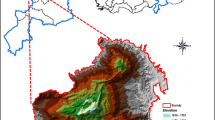Abstract
Deforestation and degradation are important aspects of landscape dynamics and have global significance. Quantification of landscape pattern using landscape metrics help in characterisation of landscapes and thus overall health of the forest cover. Himalayan foothills are one of the most important and fragile landscapes. Developmental activities and depdendence on the forest resources have altered the spatial pattern of these natural landscapes to a great extent. These changes in the landscape were analysed using satellite data from 1990, 2001 and 2006. The vegetation type maps of Dehradun forest division were prepared by supervised classification technique in order to study the landscape dynamics. Patch density, edge density, shape index, cohesion index, interspersion and juxtaposition index, normalised entropy, and relative richness are some important landscape metrics used in the study for quantifying the characteristics of landscape. The landscape metrics analysis and transformation analysis show that the forested areas are getting degraded and physical connectedness between the patches have also decreased making them isolated. The study demonstrates the importance of geospatial tools for monitoring the impact of disturbances on the forest ecosystem health, which can further help in landscape management.
Similar content being viewed by others
References
Apan AA, Raine SR and Paterson MS (2000) Image analysis techniques for assessing landscape structural change: a case study of the Lockyer Valley catchment, Queensland. Proceedings of the 10th Australasian Remote Sensing and Photogrammetry Conference, Adelaide, Remote Sensing and Photogrammetry Association, Australia, 21–25 August, pp. 438–455
Bogaert J, Ceulemans R and Eysenrode DS (2004) Decision tree algorithm for detection of spatial processes in landscape transformation. Environmental Management 33(1): 62–73
Broker W S (1987) Unpleasant surprise in greenhouse. Nature 328: 123–126
Castri Di and Hadley M (1988) Enhancing the credibility of ecology: Interacting along and across hierarchical scales. Geojournal 17:5–35
Census of India (2001) Census data of Uttaranchal. [Online]. Available on: www.censusindia.net (accessed on 10.5.09)
Colwell R N (1983) Manual of Remote Sensing, 2nd ed. Falls Church, VA: American Society for Photogrammetry and Remote Sensing Datanet India Pvt Ltd, Statistical information. [Online] (Updated 20 December, 2008) Available on: http://www.indiastat.com/ (accessed on 2.5.09)
Eastman JR (2006) IDRISI Andes: Guide to GIS and Image Processing. USA: Clark University, Worcester
Flenley J R (1979) The Equatorial Rainforests: a Geological History, London: Butterworths
Gairola S (2008) Geospatial Information Fusion for Analysing Resource Utilisation Pattern in Balkhila Sub-Watershed (Garhwal Himalayas — Gopeshwar). PhD Thesis, Forest Research Insitute, Dehradun India
Goosem M (2007) Fragmentation impacts caused by roads through rainforests. Current Science 93(11): 1587–1595
Horn SP and Sanford RL (1992) Holocene fires in Costa Rica. Biotropica 254: 354–361
ISFR (2009) India state of forest report 2009. Forest Survey of India, Dehradun
Kiensat F (1993) Analysis of historic landscape patterns with a geographic information system — a methodological outline. Landscape Ecology 8: 103–118
Lee JT, Elton MJ and Thompson S (1999) The role of GIS in landscape assessment: using land use based criteria for an area of the Chiltern Hills Area of outstanding natural beauty. Land Use Policy 16: 23–32
Lele N Joshi, PK and Agarwal SP (2008) Assessing forest fragmentation in north-eastern region (NER) of India using landscape metrics. Ecological indicators 8: 657–663
Lillesand TM, Kiefer RW and Chipman JW (2007) Remote Sensing and Image Interpretation. 5th ed. New Delhi: Wiley India Pvt Ltd
Mayaux P, Holmgren P, Achard F, Eva H, Stibig H, and Branthomme A (2005) Tropical forest cover change in the 1990s and options for future monitoring. Philosophical Transactions of The Royal Society B: Biological Sciences 360: 373–384
Nagendra H, Munroe DK and Southworth J (2004) From pattern to process: landscape fragmentation and the analysis of land use/land cover change. Agriculture, Ecosystems and Environment 101:111–115
Narumalani S, Mishra DR and Rothwell RG (2004) Change detection and landscape metrics for inferring anthropogenic processes in the greater EFMO area. Remote Sensing of Enviroment 91:478–489
National Informatics Centre, Government of India, (2000–01) Dehradun district unit. [Online] Available on: http://home.nic.in/ (accessed on 1.1.09)
Peng J, Wu J, Yin H, Li Z, Chang Q and Mu T (2008) Rural land use change during 1986–2002 in Lijang, China, Based on Remote Sensing and GIS data. Sensors 8: 8201–8223
Peterjohn WT and Corell DL (1984) Nutrient dynamics in an agricultural watershed: Observations on the role of a riparian forest. Ecology 65: 1466–1475
Rai SC, Sharma E and Sundriyal RC (1994) Conservation in the Sikkim Himalaya: traditional knowledge and land-use of the Mamlay watershed. Environmental Conservation 21: 30–34 and 56
Rai SC (1995) Land-use options in Sikkim Himalaya: an analysis from the Mamlay watershed of south district. Journal of Sustainable Agriculture 6(2/3): 63–79
Reddy CS, Rao KRM, Pattanaik C and Joshi PK (2008) Assessment of large scale deforestation of Nawarangpur district, Orissa, India: A remote sensing based study. Environmental Monitoring Assessment, DOI 10.1007/s10661-008-0400-9
Reeves RG, Anson A and Landen R (1975) Manual of Remote Sensing. Falls Church, VA: American Society for Photogrammetry and Remote Sensing, pp. 567
Shah SL (1982) Ecological degradation and future of agriculture in the Himalaya. Indian Journal of Agriculture Economics 37: 1–22
Singh JS, Pandey U and Tiwari AK (1984) Man and Forests: a Central Himalayan Case study. Ambio 13:80–87
Skole D and Tucker C J (1993) Tropical deforestation and habitat fragmentation in the Amazon: satellite data from 1987 to 1988. Science 260: 1905–1910
Thapa GB and Weber KE (1990) Actors and factors of deforestation in tropical Asia. Environmental Conservation 17: 19–27
Tucker R and Richards JF (1983) Global Deforestation and the Nineteenth Century World Economy. Duke University Press, Durham, NC
Turner M G (1989) Landscape Ecology: The effect of pattern on process. Annual Review of Ecology and Systematics 20: 171–197
University of Massachusetts Amherst, Landscape Ecology Program, FRAGSTATS documentation. [Online]. Available on: http://www.umass.edu/landeco/research/fragstats/documents/fragstats_documents.html (accessed on 27.06.2010)
Author information
Authors and Affiliations
Corresponding author
About this article
Cite this article
Munsi, M., Areendran, G., Ghosh, A. et al. Landscape characterisation of the forests of Himalayan foothills. J Indian Soc Remote Sens 38, 441–452 (2010). https://doi.org/10.1007/s12524-010-0046-2
Received:
Accepted:
Published:
Issue Date:
DOI: https://doi.org/10.1007/s12524-010-0046-2




